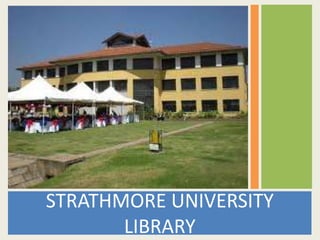Strathmore University Evaluation of Information Resources
- 2. Evaluating and using information responsiblyStrathmore University Library
- 3. Learning objectiveEvaluate and use information responsibly
- 4. Specific objectives:Evaluate information from various sources.Use information effectively to accomplish a certain purpose.Understand the legal, economic, social, and ethical aspects of information.
- 5. Why evaluate?Information overload.Any one can create and publish.Scholarly vs non-scholarly resources.
- 6. Evaluating information ŌĆō criteria R - relevanceE - expertise of the author(s)V ŌĆō viewpoint of the author/orgI ŌĆō intended audienceE - evidenceW ŌĆō when it was published
- 7. Evaluation - contŌĆÖdAccuracy ŌĆō fact vs opinion, bibliography, well researched info, logical & coherent presentation.Author ŌĆō credentials listed, authorŌĆÖs career, publication record.Reviews ŌĆō gives authorŌĆÖs background & knowledge of the subject.
- 8. Evaluation contŌĆÖdValidity ŌĆō sense in ideas & thoughts, review by an expert, reference list.Publisher ŌĆō well-known, university pressesCurrency/timeliness - up-to-dateBias ŌĆō noticeable bias, personal biasScope - coverage
- 9. Using informationYou've identified, located, and evaluated information created by other people.Now it's time to utilize that information.
- 10. Using information responsiblyAs a student who uses information and writes assignments, you should be aware of what constitutes academic integrity.Academic integrity is founded on the principles of respect for knowledge, truth, scholarship and acting with honesty. Lack of it amounts to academic dishonesty.
- 11. Academic dishonestyAcademic fraudPlagiarismResearch misconductViolation of copyright law
- 12. Academic fraudMaking a false representation to gain an unjust advantage.Falsification of data Dishonest conduct in relation to exams or other assessment itemsReusing work you have previously submittedContract cheating.
- 13. PlagiarismIs the act of presenting another person's work or ideas as your own. Plagiarism is a type of intellectual theft. It can take many forms, from deliberate cheating to accidentally copying from a source without acknowledgement.
- 14. Plagiarism- contŌĆÖdCollusion or working with others and presenting the resulting work as though it was completed independently.
- 15. Common forms of plagiarismDownloading an assignment from an online source.Buying, stealing or borrowing an assignment.Quoting from a source 'word for word', without using quotation marks.Copying, cutting and pasting text from an electronic source.
- 16. Forms of plagiarismUsing the words of someone else.Lifting sentences or paragraphs from someone else.Relying too much on other people's material. Avoid repeated use of long quotations.
- 17. Avoiding plagiarismKeeping careful notes as you do your research. Rephrasing ideas into your own words as you take notes. Documenting your research by creating a complete bibliography.
- 18. Exceptions to plagiarismLocal knowledgeShared experiencesCommon facts
- 19. Research misconductResearch misconduct includes:Fabrication, falsification, plagiarism or deception in proposing, carrying out or reporting the results of research, Failure to declare or manage a serious conflict of interest,
- 20. Research misconductAvoidable failure to follow research proposals as approved by a research ethics committee.Willful concealment or facilitation of research misconduct by others.
- 21. QuestionWhat are some of the good practices you would apply for academic integrity?
Editor's Notes
- Contract cheating - paying someone to produce an essay or assignment and then submitting the work as your own.
- Effective note takingParaphrasing appropriately Summarizing correctly and efficientlyUsing direct quotations appropriatelyUsing 'common knowledge' Organizing your sourcesReferencing your sources correctly.





















